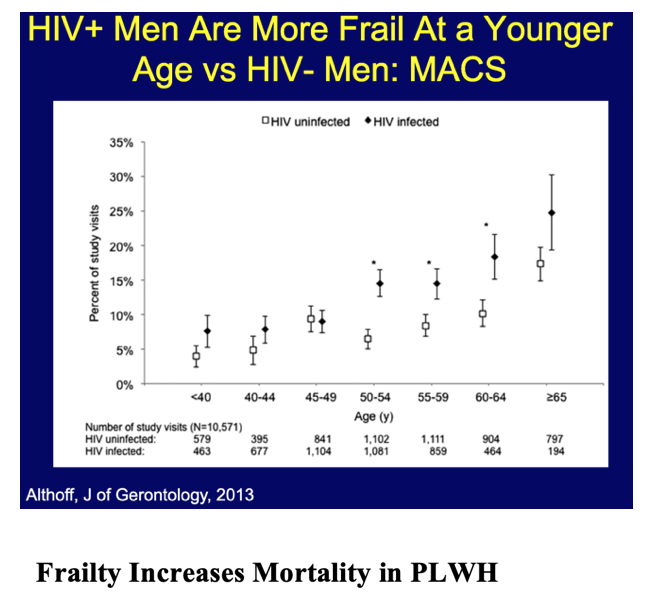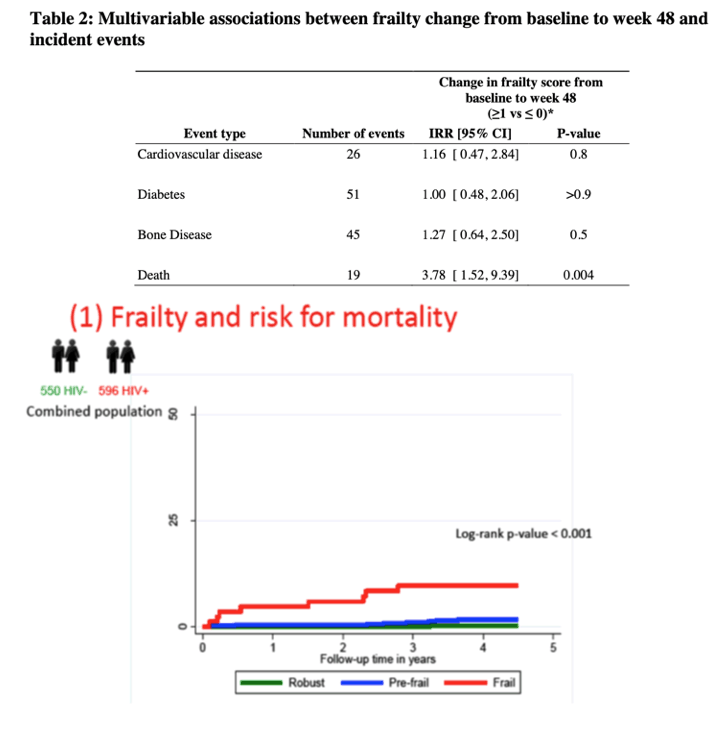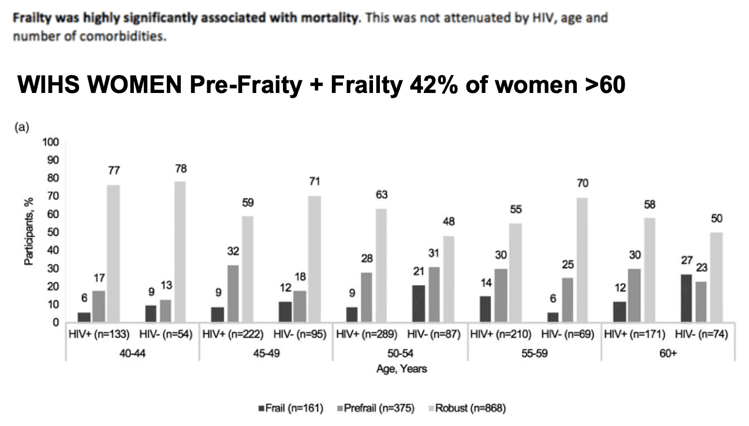| |
What is Frailty in PLWH ? 25% of HIV+ Men in MACS >65 Were Frail in 2013; 42% of HIV+ Women >60 in WIHS in 2019 were Frail/Pre-Frail. Frailty Increases Mortality
|
| |
| |
Frailty is a vulnerability state characterized by impairments and limitations that might lead to disabilities. It represents the vulnerability that increases risk of negative health outcomes, loss of independence, and of mortality [8]. Studies show that adults with HIV infection experience a prevalence of frailty equivalent to and even greater than that observed in elderly. [16, 20, 21]. The reason for this early manifestation of frailty may be a consequence of the HIV infection itself, suboptimal medication and control of infection early on, comorbid diseases (infectious or non-infectious) [21, 22] and/or other lifestyle habits, such as smoking and substance use, which are more common among those with HIV infection [23]. Physical frailty may be due to the HIV infection, itself. With a dropping CD4 cell count, the immune system is insufficient to protect against both infectious and chronic diseases such as cancer, cardiac diseases, and diabetes. Moreover, HIV infection is accompanied by numerous symptoms that weaken the body, including pain, weight loss, and fatigue or weakness [24]. Physical deterioration leads to vulnerability to diverse pathologies, which can lead to premature frailty among HIV-infected.
To address our question, we engaged WIHS frailty measures collected among 2028 HIV+ (n = 1449) and at risk HIV- (n = 579) WIHS women, during midlife (average age 39 years). At midlife, we operationalized the FFI similarly to the Multicenter AIDS Cohort Study (MACS), which is composed of HIV+ and HIV- men [15]. The WIHS Core battery provided FFI, HIV status, and constellations of variables representing demographic/health behaviors and aging-related chronic diseases. With an age range of 50-64 years, MACS observed 12% frailty prevalence among HIV+ and 9% among HIV- men [20]. In contrast, using similar criteria in the WIHS, the overall frailty prevalence was 15% (HIV+, 17%; HIV-, 10%) among women at midlife. A stepwise multivariable model suggested that HIV infection with CD4 count <200; age >40 years; current or former smoking; income ≤$12,000; moderate vs low FIB-4 levels; and moderate vs high eGFR were positively associated with FFI. Low or moderate drinking was protective. Typical aging-related co-morbidities such as obesity, type 2 diabetes, cardiovascular disease, and hypertension, as well as recreational drug use and self-reported or historically measured co-infections were not significantly associated with frailty in the final multivariate model. These results show that frailty is a multidimensional aging phenotype observed even in midlife among women with HIV infection; suggest that the frailty constellation may change with age; and show that prevalence of frailty in HIV-infected WIHS women exceeds that for usual elderly populations.

Concordance of FP+ status and comorbidities was high, but a sizable proportion of HIV+ and HIV- men were FP+ with fewer than
two comorbidities, suggesting that FP+ and comorbidities are not synonymous. The prevalence of the FP increased with age in both
HIV+ and HIV- men, as expected, but was higher in HIV+ men aged 50–64 years compared with HIV- men of the same age; rates of comorbidities associated with expression of the FP were higher in HIV+ than HIV- men. Conversion from FP- to FP+ status was significantly associated with the presence of conditions known to be associated with expression of the FP in elderly HIV- people (eg, depressive symptoms, diabetes, kidney disease, hepatitis C infection, and cigarette smoking). The fact that many factors and organ systems were associated with conversion suggests that expression of the FP is indicative of multisystem dysfunction in our study population, as it is in the older HIV- population.
HIV infection, independent of these comorbidities, was significant only in the presence of a history of AIDS, suggesting that men
who had AIDS before the introduction of HAART may have driven the association of HIV infection with expression of the FP; aving attained a college degree or beyond was significantly associated with a lower odds of frailty conversion, similar to cross-sectional studies of HIV+ adults in which frailty was associated with lower education attainment (44), unemployment (41), and homelessness (44). There was a greater prevalence of comorbidities (hepatitis C, depression, diabetes, and kidney disease) in HIV+ compared with HIV- men. Most men who were FP+ had two or more comorbidities at first visit in this study (66% of HIV+ and 62% of HIV- men). The proportions of men with the FP but less than two comorbidities (34% for HIV+ and 38% for HIV- men) were similar to that in the study population in which the FP was first described (30%) (7). https://www.natap.org/2014/HIV/JMedci-2014-Althoff-189-98.pdf

we found in ACTG 5322 that the presence of frailty and increases in frailty scores over
time among treated, virally-suppressed PWH preceded multiple chronic disease-specific events
and mortality.


Ideas for Going Forward
This overview of frailty among participants in the WIHS highlights the need for geriatricians and gerontologists to interact with younger "at risk" populations and assist in the formulation of best recommendations for frailty interventions to prevent early aging, excess morbidities, and early death. In terms of preventing frailty, implementation of prevention measures should be adapted to the patient's health, needs, and motivation. Family and social networks should be assessed as well to determine support needs.
According to PubMed, frailty was first reported in 1956, in an article entitled "Frailty of old age and bacterial allergy" [9]. Subsequent to initial, isolated reports, frailty as a health outcome became consistently reported beginning in the late 1980s. Since then, varying definitions of frailty and essential components of frailty have been put forward. For example, frailty has been defined as a clinical syndrome [10]-a composite of physical symptoms, referred to as the frailty phenotype (FP) [11]-and the accumulation of deficits [12, 13]. Underlying all definitions of frailty is the concept that to prevent the sequelae, which includes disability followed by death; the reversible frail state must be identified using a screening tool (see Table 1 for list of published frailty indices). Most geriatric indices and scales used in clinical practice to assess health in aging adults do not assess frailty in its entirety but can be used to assess selected components of the frail state.
The Fried Frailty Index (FFI), a physical frailty index, was validated in the Cardiovascular Health Study in 1998 and by Kiely in 2009. The FFI is a useful construct to predict poor quality of life, cognitive impairment, dementia, and death [14]. The FFI is composed of five components: weakness, slowness, exhaustion, low physical activity, and unintended weight loss [11]. Fulfilling at least three of the five components denotes frailty. However, the faces of frailty include emotional, social, cognitive, metabolic, and sensory frailty existing alongside physical frailty (see Fig. 2); thus, the FFI has been associated with other health indices such as the Center for Epidemiologic Studies Depression scale (CES-D scale) [5, 15, 16].
In traditional studies of aging, elderly people are classified into one of three categories: robust, frail, and disabled [7] (see Fig. 1). To be robust is to be without frailty or disability. Frailty is a vulnerability state characterized by impairments and limitations that might lead to disabilities. It represents the vulnerability that increases risk of negative health outcomes, loss of independence, and of mortality [8]. In contrast, being disabled means there are important deficits that restrict a woman from performing daily activities on her own. Whereas frailty seems to be reversible and sensitive to prevention, disability tends to be permanent and may lead to hospitalization, institutionalization, and death. This classification is essential to evaluate health in aging populations and to provide appropriate health care. It is crucial to detect frail adults before they become disabled and to apply active prevention measures of this irreversible state.
|
|
| |
| |
|
|
|